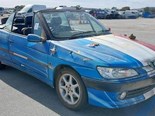Citroen 2CV Review
 Citroen 2CV
Citroen 2CV

 Citroen 2CV
Citroen 2CV

 Citroen 2CV
Citroen 2CV

 Citroen 2CV
Citroen 2CV

 Citroen 2CV
Citroen 2CV

 Citroen 2CV
Citroen 2CV

 Citroen 2CV
Citroen 2CV


|
|
Citroen 2CV
|

|
|
Citroen 2CV
|

|
|
Citroen 2CV
|

|
|
Citroen 2CV
|

|
|
Citroen 2CV
|

|
|
Citroen 2CV
|

|
|
Citroen 2CV
|
Citroen’s baby 2CV was probably the world’s first cross-over vehicle

|
|
Citroen 2CV
|
Citroen 2CV
A young child growing up in Australia after World War II didn’t have the flattened cities and homes of Europe and Asia as reminders of war. One of our most visible symbols, apart from the odd plane and army surplus Jeep or Blitz truck, was the Nissen hut.
Invented by Canadian mining engineer Peter Norman Nissen for the British military in World War I, these semi-circular huts looked like a giant corrugated iron water tank sliced in two then joined end for end. Nissen’s brief was a portable shelter for men and machinery that could be assembled by four men in four hours and required less shipping space than an equivalent canvas structure.
In the early 1950s, you could stumble across a Nissen hut in the middle of an Australian city or the middle of nowhere following the wartime scramble to house personnel and equipment across a sparsely inhabited continent. The sight of a Nissen hut would generate a more somber mood in those who had just left the war behind.
For my father, it was a reminder of air force life across Great Britain and Africa. For my mother, it was the Italians she had taught English after work in a remote rural area after they had been locked-up for the duration of the war in case they were fascists.
The significance of the Nissen hut grew as childhood migrant friends recounted their first days in Australia. They were often violent stories of separated families sharing cramped Nissen huts with nationalities who were killing each other only years earlier. It was during this period that I first encountered the Citroen 2CV in grainy newsprint photos and bleak newsreels on French troublespots.
Because we were told that the French and Dutch had done it extra tough under the Germans, I had concluded that the French were forced to cut up their Nissen huts and put wheels under them. I figured that Australians got off lightly when we had the FJ Holden. Even if this was a child’s imagination at work, it was not totally without foundation. The Nissen hut and the 2CV came from the same minimalist thinking, both using the same principles and materials to replicate the function of far more complex structures.
The new baby Citroen, available only in grey initially, was little more than two half-circle body sections that housed lift out doors separated by a corrugated bonnet and a roll of fabric to cover the seats and boot. In profile, it was close enough to a Nissen hut. Seats were hammocks strung across tubular frames while the speedo provided drive for the wipers – smarter than our FJ when its vacuum wipers stopped while overtaking or climbing a hill.
The first 2CV had a tiny 375cc flat twin loosely modelled on a BMW motorcycle engine that needed 3800 rpm to deliver 9 bhp/6.7kW. You got a dipstick to check the fuel and an ammeter to keep track of the generator hanging off the crank. The air-cooled engine had one-piece conrods fitted to the journals before the crankshaft was assembled and with the standard oil cooler, it could scream its head off without breaking.
For minimalist, cheap transport, it had amazing interconnected suspension, inboard front brakes and was the first budget car with Michelin radials.
If it wasn’t for Citroen chief Pierre Boulanger’s wife wanting something a little more habitable, it would have been coated inside and out with the flecked stove enamel found in ovens at the time. Arguably the first cross-over passenger car, it had to transport a basket of eggs across a ploughed field without breaking any. With doors and seats left behind and fabric roof and boot cover rolled up, it could provide ute-style transport for stock and farm equipment.
Not long after its October 1948 release, it generated a three year waiting list as it was perfect for post-war rationing and France’s rural roads. Production started in England in 1953 with key differences to bumpers, lights and other ancillaries. Some came here but the biggest early RHD customer was the British navy after the 2CV was assigned to helicopter-borne light reconnaissance duties on carriers.
I hadn’t realized how potent the link between the Citroen 2CV and Nissen hut had become until the 1970s. I had gone to Munich to soak up the beer and BMW’s flash new headquarters but instead explored Bavaria with a French art student in her 2CV. Although much richer for the experience, I had half-expected the panels of the baby Citroen to flap like a bush tin shed in a stiff northerly, an impression reinforced by the flip-up side windows. Instead, it felt like I was riding a magic carpet over some mild turbulence as its French driver deftly flicked the gear lever sprouting out of the dash to keep its tiny engine on the boil.
At the time, the joke was you could tell the nationality of a 2CV driver by which elbow had gravel rash. The angles that the tiny Citroen would reach in a corner would be alarming in anything else but its grip and balance were outstanding. I wasn’t the only Australian seduced by the 2CV as the first rush of imports began during this period. Today, Citroen 2CV raids are held regularly in Australia and their European owners are persuaded with fat wads of cash to leave their 2CVs behind creating further waves of imports.
As wartime deprivations faded, Citroen had to re-invent the 2CV as its austerity and lack of power were no longer acceptable. It was promoted as "an umbrella on wheels" and "a whole lifestyle" after the flower power generation embraced it as a one finger salute to consumption and aggression. By 1970, you could choose a 2CV4 with 435cc/18 kW or 2CV6 with 602cc/21kW. Its high labour component ended French production in 1988 but it was built at Mangualde in Portugal until July 27,1990.
In 2004, the most sobering epitaph for the last 2CV is that it could now comfortably break the speed limits of most Australian states. Despite the huge advances in technology and roads since 1948, most Australians are now forced to travel at speeds almost a dawdle for a 21 kW Citroen 2CV, a car that started life as a substitute for a farmer’s horse and cart!
Unique Cars magazine Value Guides
Sell your car for free right here
Get your monthly fix of news, reviews and stories on the greatest cars and minds in the automotive world.
Subscribe

.jpg)




